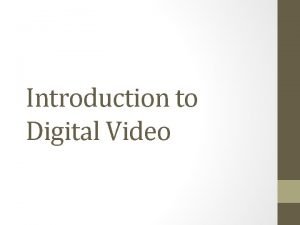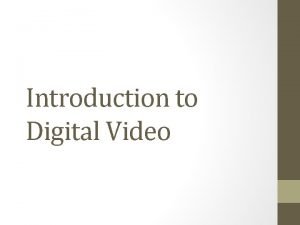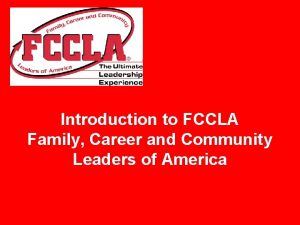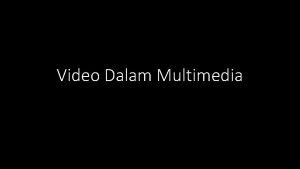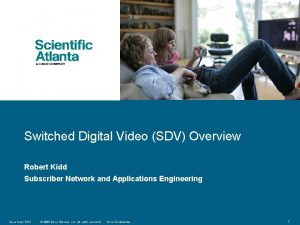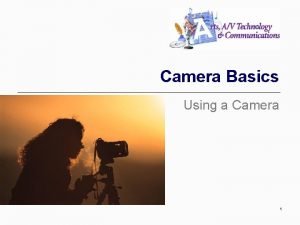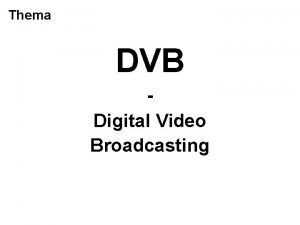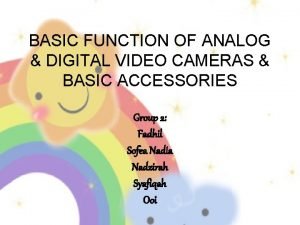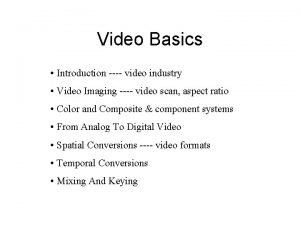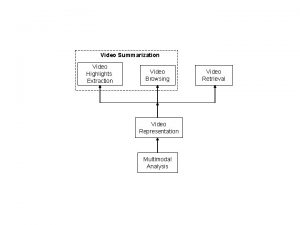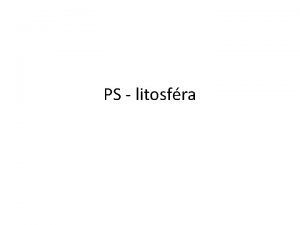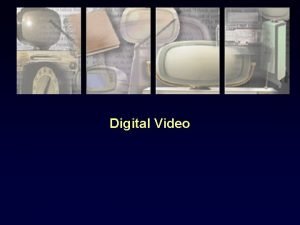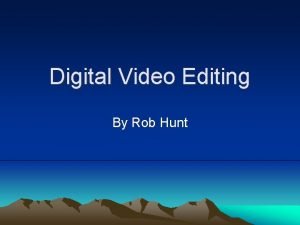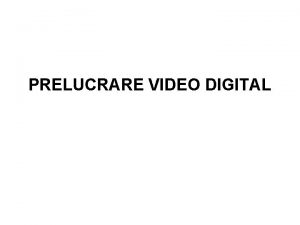Introduction to Digital Video Digital Video Digital vs












- Slides: 12

Introduction to Digital Video

Digital Video • Digital vs. Analog • Analog video uses a continuous electrical signal to capture footage on a magnetic tape. Examples would include VHS, 8 mm. • Digital videos are made up of 1’s and 0’s, binary format, that represent the video image which computers can read.

Digital Video Terms • Capture: To record audio, video, or still images as digital data in a file. • Frame: a single picture or still shot, that is one of many sequential images that make up video. • Frame Rate: The number of video frames displayed per second (FPS). Higher frame rates generally produce smoother movement in the picture. • NTSC Television: 24 fps (23. 976). Worldwide standard for movie theater projectors and television. • Many movies are now being shot at higher frame rates, such as 30 fps or 48 fps (HFR).

Digital Terms (Continued) • Display Resolution: the number of pixels that can be displayed on a digital screen, usually quoted as width x height. • (480 p): 720 x 480 • NTSC DV (Television) and DVD standard. • (720 p): 1280 x 720 • HD Video capable of high frame rates, but smaller dimensions than 1080 p. • (1080 p): 1920 x 1080 • HD Video with high resolution.

Phases of Video Production • Preproduction • Postproduction

Preproduction • The events that take place prior to the actual shooting of the video. • Idea Generation (Brainstorming) • Producing ideas through spontaneous group discussion. Lets Brainstorm: As a class come up with ten ideas for a new comedy show that would target young people. Example: A show about a family can talk to their pets. Each pets personality fits their species: dogs are simple, cats are snotty, hamster is energetic. • Script Writing • The written text for your movie.

Preproduction (Continued) • Storyboarding • A sequence of drawings, with directions and sometimes dialog, that represents planned shots for a movie.

Preproduction (Continued) • Casting - finding appropriate people to play the roles of the video • Scouting Locations • • • Look and feel Associated cost Lighting Permission Logistics • Power • Distance • Parking

Production • The actual shooting/recording of the video. • Framing Shots/Field of View • • Shot Types: Wide, Medium, Tight Panning and Zooming Panning Zooming • Audio • Microphone Choice: On Board, Shotgun Mic, Boom Mic • Lighting • Natural vs. Artificial

Postproduction • All events between production and creating the final version of the video. • Capturing Video - importing video from the original recording device. • Trimming Clips and Creating Sequences • Clips: Small segments of a larger video. • Trim: To hide parts of a file or clip without deleting them from the original source. • Sequence: A variety of wide, medium, and tight video shots edited together to compress time, add interest, and help the viewer movie efficiently through a story. • Timeline: Shows the components of the movie such as photos, video, audio clips and titles in the order and timing that they will appear in movie.

Postproduction (Continued) • Adding Titles and Graphics • Rolling credits- Include cast and credits for sources. • Adding/Editing Sound • Soundtracks or sound effects: Additional audio added as background or to enhance specific points in the video. • Narration: Audio of one or more people that has been recorded to enhance or assist in telling the story for your video. • Apply Effects • Transitions: The visual movements as one picture, video clip, or title changes to another. Transitions are not applied directly to the clips, but are used to move from one to another. (Common: Cross Dissolve) • Video Effects: Enable you to add special effects to your movie. An example would be adding a Film Age video effect to make your movie clip to look like that of an old time movie or making the video black and white.

Postproduction (Continued) • Exporting • Common Video File Types • . avi (Audio Video Interleave) • Created by Microsoft; Uses less compression than MOV or MPEG; Supported by almost all computers using Windows • . mov (Apple Movie) • Developed by Apple Computer; Cross-Platform; Opens with Apple Quick. Time • . mp 4 (MPEG-4) • Developed by Moving Pictures Expert Group; Compresses well; Commonly used for the Internet • . flv (Flash Video) • Developed by Adobe Systems; Commonly used to deliver video over the Internet by using Flash Player; Used by You. Tube, Hulu, VEVO, etc…
 Introduction digital video
Introduction digital video Introduction to digital video
Introduction to digital video Yandex ru video search text video
Yandex ru video search text video Gravity yahoo
Gravity yahoo Video.search.yahoo.com search video
Video.search.yahoo.com search video Digital media primer
Digital media primer What are the benefits of joining fccla
What are the benefits of joining fccla Pengertian video digital
Pengertian video digital Sdv video
Sdv video Analog vs digital
Analog vs digital Digital video camera basics
Digital video camera basics Dvb digital video broadcasting
Dvb digital video broadcasting Analog and digital video in multimedia
Analog and digital video in multimedia
